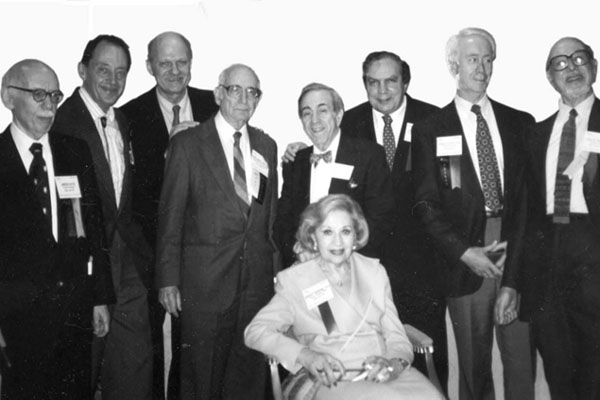Find a CBT Therapist
Search through our directory of local clinicians.
History of ABCT
The organization was originally founded in 1966 under the name Association for Advancement of Behavioral Therapies (AABT; Franks, 1997) by 10 behaviorists who were dissatisfied with the prevailing Freudian/psychoanalytic model (founding members: John Paul Brady, Joseph Cautela, Edward Dengrove, Cyril Franks, Martin Gittelman, Leonard Krasner, Arnold Lazarus, Andrew Salter, Dorothy Susskind, and Joseph Wolpe). Although AABT/ABCT was not established until 1966, its history begins in the early 1900s with the birth of the behaviorist movement, which was brought about by Pavlov, Watson, Skinner, Thorndike, Hull, Mowrer, and others-scientists who, concerned primarily with observable behavior, were beginning to experiment with conditioning and learning theory. By the 1950s, two entities-Hans Eysenck’s research group (which included one of AABT’s founders Cyril Franks) at the University of London Institute of Psychiatry, and Joseph Wolpe’s research group (which included another of AABT’s founders, Arnold Lazarus) in South Africa-were conducting important studies that would establish behavior therapy as a science based on principles of learning. In complete opposition to the psychoanalytic model, “The seminal significance of behavior therapy was the commitment to apply the principles and procedures of experimental psychology to clinical problems, to rigorously evaluate the effects of therapy, and to ensure that clinical practice was guided by such objective evaluation” (Wilson, 1997).
The first president of the association was Cyril Franks, who also founded the organization’s flagship journal Behavior Therapy and was the first editor of the AABT Newsletter. The first annual meeting of the association took place in 1967, in Washington, DC, concurrent with the American Psychological Association’s meeting.
An article in the November 1967 issue of the Newsletter, entitled “Behavior Therapy and Not Behavior Therapies” (Wilson & Evans, 1967), influenced the association’s first name change from Association for Advancement of Behavioral Therapies to Association for Advancement of Behavior Therapy because, as the authors argued, “the various techniques of behavior therapy all derive from learning theory and should not be misinterpreted as different kinds of behavior therapy…” (quoted in Franks, 1987). This issue remains a debate in the field and within the organization, particularly with the emergence of the term “cognitive behavioral therapies,” which resulted in yet another name change in 2005 to the Association for Behavioral and Cognitive Therapies.
AABT/ABCT has been at the forefront of the professional, legal, social, and ethical controversies and dissemination efforts that have accompanied the field’s evolution. The 1970s was perhaps the most “explosive” (see Stuart, 1974) and controversial decade for the field of behavior therapy, as it suffered from an overall negative public image and received numerous attacks from the press regarding behavior modification and its possible unethical uses. In Gerald Davison’s (AABT’s 8th president) public “Statement on Behavior Modification from the AABT,” he asserted that “it is a serious mistake…to equate behavior therapy with the use of electric shocks applied to the extremities…” and “a major contribution of behavior therapy has been a profound commitment to full description of procedures and careful evaluation of their effects” (Davison & Stuart, 1974, p. 3). From this point, AABT became instrumental in enacting legislative guidelines that protected human research subjects, and they also became active in efforts to educate the public.
The training of mental health professionals has also been a significant priority for the association. Along with its annual meeting, AABT created an “ad hoc review mechanism” in the 70’s through the 80’s whereby a state could receive a review of a behavior therapy program. This led to the yearly publication of a widely used resource, “The Directory of Training Programs.” With growing concerns over quality control and standardization of practice, the certification of behavior therapists also became an issue in the 1970s.
An ongoing debate within the association concerns what many consider to be a movement away from basic behavioral science as the field has attempted to advance and, in doing so, integrate more and more “new” therapies/specializations, particularly the addition of cognitive theory and its variety of techniques. John Forsyth, in his special issue of Behavior Therapy (Forsyth & Hawkins, 1997) entitled “Thirty Years of Behavior Therapy: Promises Kept, Promises Unfulfilled,” summarized this opposition as follows: “(a) cognition is not behavior, (b) behavior principles and theory cannot account for events occurring within the skin, and most important, (c) we therefore need a unique conceptual system to account for how thinking, feeling, an other private events relate to overt human action.” (Forsyth, 1997, p. 621). The field’s desire to maintain its scientific foundations and yet continue to advance and grow was reflected in its most recent discussion about adding the word “cognitive” to the name of the association (see the Oct. 2003 special issue [Antony, 2003] in the Behavior Therapist: “Is It Time for AABT to Change Its Name?”)
Many notable scholars have served as president of the association, including Joseph Wolpe, Arnold Lazarus, Nathan Azrin, and David Barlow. The current executive director of the ABCT is Mary Jane Eimer, CAE. For a wealth of historical specifics (governing bodies, lists of editors, past presidents, award winners, SIGs, and conventions from the past 40 years) see ABCT’s 40th anniversary issue of the Behavior Therapist (Albano, 2006).

